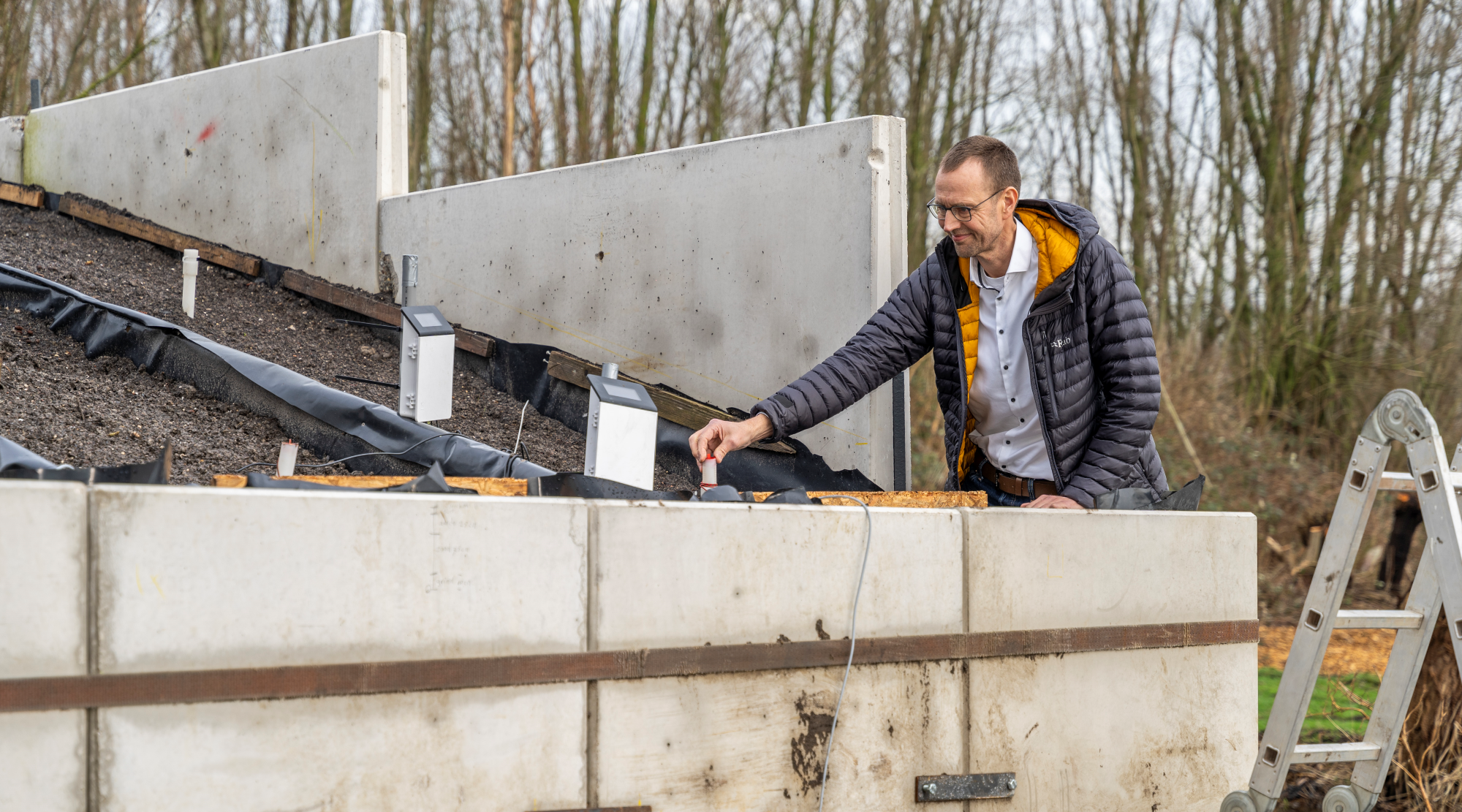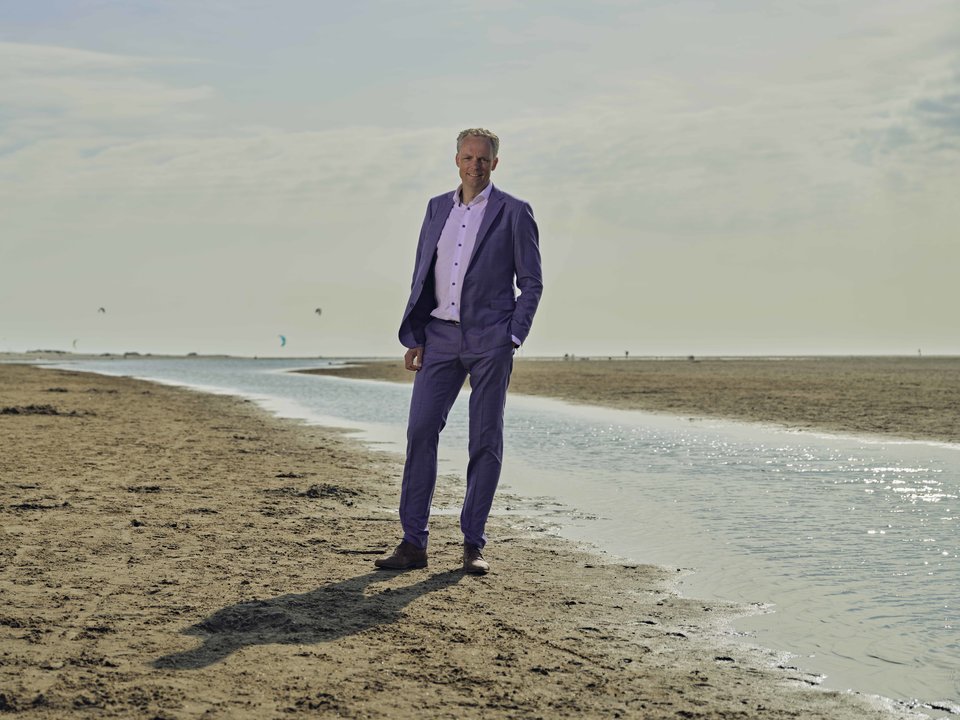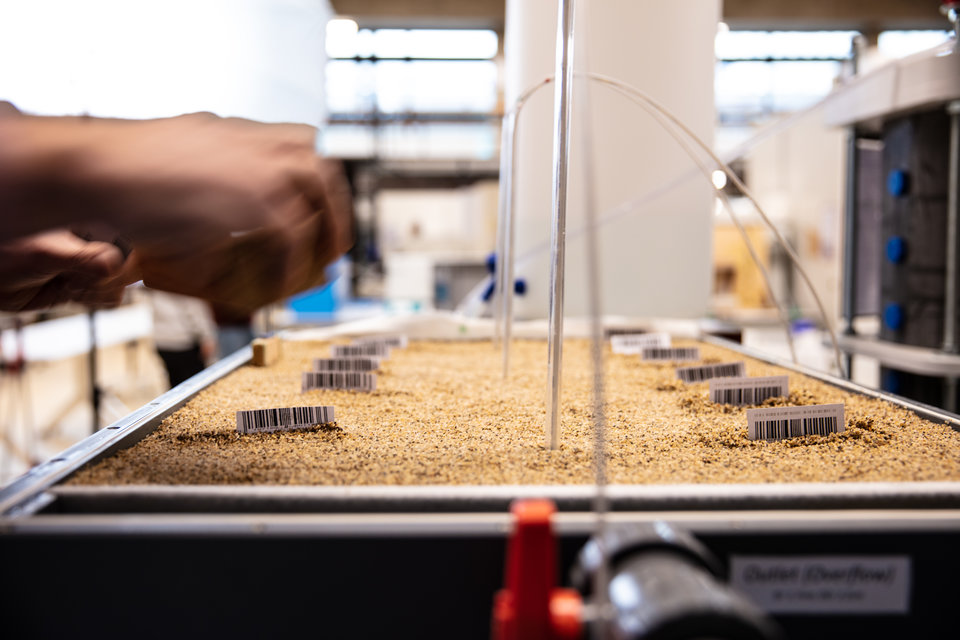Nature-based solutions have become increasingly popular when it comes to finding ways to discharge or store water. How these behave in time is largely unknown, however. Two trial setups at Flood Proof Holland, to be studied over at least ten years, will give hydrologist Thom Bogaard and his team of students and other researchers a better understanding of the long-term effects of nature-based solutions. The outdoor setups will also provide plenty of opportunities for “multidisciplinary cross-pollination”.
Smart water management technology, such as storm surge barriers, drainage systems, dikes and dams, have made the Netherlands what it is today. But now, more often than not, scientists are looking to nature to help them store and discharge water. Examples include rewildering waterways to combine safety against floods and droughts with nature restoration, as well as opting for sustainable urban drainage systems (SuDS). These green swales in neighbourhoods or parks hold onto rainwater so it can gradually infiltrate into the soil.
Resilient and sustainable
Natural solutions have several important advantages, hydrologist Thom Bogaard says. “They are resilient and sustainable. By working with nature you create multiple ecosystem services. A nature-based solution is not just a way of managing storage and runoff, it also increases biodiversity, captures pollutants from the environment and lowers ambient temperature. It also has a greater aesthetic value and lasts longer. And if there is damage, for instance from a storm or drought, the system will largely repair itself.”
We have a pretty good idea of what happens to concrete structures during time. It’s a lot harder to tell when it comes to a natural system.
Little research into the long-term
If nature-based solutions have a flaw it is that little is known about their long-term effects. “Concrete structures will last some 50 to 100 years and we have a pretty good idea of what happens to them in that time. It is a lot harder to project what will happen to a natural system. Its development is much more dynamic and, despite its resilience, drought or excessive rainfall can have far-reaching consequences. As yet, there is very little data to tell us how the soil and life in the soil will be affected and if, say in 30 years, our assumptions about storage and discharge capacities are still valid.”
More robust design without back-up
To prevent eventualities, nature-based solutions in urban areas are often made more secure by a more conventional backup system. “SuDS are often fitted with a drainage pipe, for instance,” Bogaard says. “It’s a logical solution in some places but in others it’s an unnecessary cost. What’s wrong with a bit of water on the edge of a park for a couple of days or weeks? What we do need to know is how that surface water storage affects the environment. It could, for instance, attract mosquitos and with rising temperatures that could result in the spread of mosquito-borne disease. That is a focus of multidisciplinary research, with our colleagues from Leiden and Rotterdam.”
Big research setups at Flood Proof Holland
To find out how nature-based solutions behave in the longer term, Bogaard enlisted the help of flood resilience field lab Flood Proof Holland. Two large set-ups with concrete walls measuring 7.5 by 3.5 metres and a couple of metres in height were installed on its premises. “These have been divided into three adjacent sections built up of gravel, sand and a layer of vegetation. The layers have been equipped with sensors so we can monitor what is happening to them. The big difference between the set-ups is that one is level and the other has been tilted at a 17-degree gradient. That will give us a chance to experiment with stabilising eroding slopes with willow branches.”
The set-up with the level base is meant for research into SuDS, Bogaard says. “We will be planting several types of grass and making a swale. One of the three compartments is left as is, as a control. That part will be used to see how long it takes for the water to be absorbed into the soil and what the consequences of rapid or slow water absorption have on biodiversity, including mosquito populations. The two other parts of the tank will be used to experiment with the spread of pollutants, such as rubber nanoparticles or microplastics.”
Missing link
Bogaard describes the work he and his team are doing at Flood Proof Holland as a combination of fieldwork and lab work. The large-scale outdoor set-ups are exposed to the elements, which will determine their natural development and long-term behaviour. “In-situ research is great but also bound by its locality. On the other hand, the lab is a controlled environment, often small-scale and untouched by outside influences. The outdoor setups we have at Flood Proof Holland enable us to study nature-based solutions to a realistic degree. This is a missing link in research practice, and that is a great shame, particularly because it is of such great use in investigations with lots of unknowns. I’m a great advocate of more open-air labs such as this.”
Awareness
To Bogaard, the setup in Flood Proof Holland is more than a place to carry out his research. “It’s also a means to make students aware of the importance of long-term research into nature-based solutions and to get them involved. It’s great to see that students from for example Landscape and Building Environment who are studying water storage in urban settings are very interested in the work we are doing. The findings from our hydrological research can be extremely relevant to the designs of SuDS, typically designed with in multidisciplinary teams. I’m looking forward to many more of these multidisciplinary cross-pollinations.”



![[Translate to English:] [Translate to English:]](https://filelist.tudelft.nl/_processed_/d/c/csm__AHK5883_1%20header_811d0903f9.jpg)
![[Translate to English:] [Translate to English:]](https://filelist.tudelft.nl/_processed_/7/7/csm_DSCF4928_b15d024bac.jpg)

